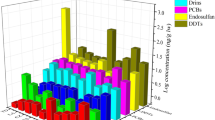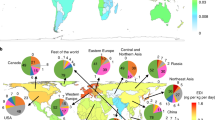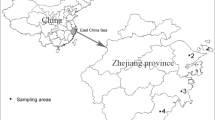Abstract
Many studies show that dietary consumption of fish is the greatest contributor to dioxin exposure of humans in Japan. To establish a link between ocean contamination and human exposure to dioxins in fish, we proposed a method of estimating exposure by integrating region-specific measured concentrations of dioxins in fish samples and information on the production and import–export volumes of fish. The advantage over “total diet studies” (TDS) was that the proposed method could analyze the impact of the geographical variability of ocean contamination on human exposure to dioxins in fish; this may help us to apply more effective measures against dioxin exposure. Probabilistic distributions (probability density functions (PDFs)) were assigned to express the variability in the results of monitoring dioxin concentrations in fish from coastal areas divided according to prefecture, and from offshore and distant waters and imported sources. The Monte Carlo technique was applied for probabilistic estimation of dietary exposure of the general Japanese population to dioxins in fish. The mean and 5th to 95th percentile range of dietary exposure were estimated, respectively, as 67.12 and 22.65–184.35 pg toxic equivalent per day. Sensitivity analysis showed that some specific coastal areas with higher dioxin levels in fish and some with larger production volumes of fish impacted more than others to total exposure and may thus attract priority in the implementation of dioxin abatement measures.
This is a preview of subscription content, access via your institution
Access options
Subscribe to this journal
Receive 6 print issues and online access
$259.00 per year
only $43.17 per issue
Buy this article
- Purchase on Springer Link
- Instant access to full article PDF
Prices may be subject to local taxes which are calculated during checkout






Similar content being viewed by others
References
Cullen A.C., and Frey H.C. Probabilistic Techniques in Exposure Assessment: a Handbook for Dealing with Variability and Uncertainty in Models and Inputs. Plenum, New York, 1999 pp. 143.
Environment Agency of Japan. Report of Committee on Risk Assessment of Dioxins. Planning and Coordination Bureau, Tokyo, 1997 (in Japanese).
Food Marketing Research and Information Center (FMRIC). Report on the Investigation of the Seafood Circulation: Trades on Domestic Wholesale Markets. Tokyo, 1999 (in Japanese).
Food Marketing Research and Information Center (FMRIC). Report on the Investigation of Wholesale Markets. Tokyo, 2000 (in Japanese).
Government of Japan. Dioxins. 2003, http://www.env.go.jp/en/topic/dioxin/brochure2003.pdf, 2004.
Lunchick C. Probabilistic exposure assessment of operator and residential non-dietary exposure. Ann Occup Hyg 2001: 45 (1001): S29–S42.
Masunaga S., Yao Y., Ogura I., Nakai S., Kanai Y., and Yamamuro M., et al. Identifying sources and mass balance of dioxin pollution in Lake Shinji Basin, Japan. Environ Sci Technol 2001: 35: 1967–1973.
Ministry of Agriculture, Forestry and Fisheries of Japan (MAFF). Annual Statistical Report of Seafood Circulation. Tokyo, 2004a (in Japanese).
Ministry of Agriculture, Forestry and Fisheries of Japan (MAFF). Annual Statistical Report on Production of Fisheries and Aquaculture, 2002. Tokyo, 2004b (in Japanese).
Ministry of Agriculture, Forestry and Fisheries of Japan (MAFF). Investigation of Dioxins in Seafood, 1999–2001. Tokyo, 2002 (in Japanese).
Ministry of Agriculture, Forestry and Fisheries of Japan (MAFF). Supplied data, Statistics on fish production by prefecture, 2002. Fisheries Agency, Tokyo, 2004c.
Ministry of Health, Labor and Welfare of Japan (MHLW). National Nutrition Survey, 2001. Tokyo, 2003 (in Japanese).
Ministry of Health, Labor and Welfare of Japan (MHLW). Total Dietary Studies, 1998–2002. Tokyo, 1999–2003 (in Japanese).
Ministry of the Environment (MOE). Survey of Dioxins in Public Water Areas, etc., 1999. Tokyo, 2000 (in Japanese).
Osaka Central Wholesale Market. Annual Report of Osaka Central Wholesale Market, 2002. Osaka, 2003 (In Japanese).
Sakurai T. Dioxins in aquatic sediment and soil in the Kanto region of Japan: major sources and their contributions. Environ Sci Technol 2003: 37: 3133–3140.
Suzuki N., Ishikawa N., Takei T., Mato Y., Nakayama S., and Uchiyama I., et al. Human exposure to PCDDs PCDFs and Co-PCBs in Japan. Organohalogen Comp 2000: 64: 67–70.
Suzuki N., Murasawa K., Sakura T., Nansai K., Matsuhashi K., and Moriguchi Y., et al. Geo-referenced multimedia environmental fate model (G-CIEMS): model formulation and comparison to the generic model and monitoring approaches. Environ Sci Technol 2004: 38: 5682–5693.
Tajimi M., Watanabe M., Oki I., Ojima T., and Nakamura Y. PCDDs PCDFs and Co-PCBs in human breast milk samples collected in Tokyo, Japan. Acta Paediatrica 2004: 93 (8): 1098–1102.
Takayama K., Miyata H., Aozaki O., Mimura M., and Kashimoto T. Dietary intake of dioxin-related compounds through food in Japan. Shokuhin Eisegaku Zasshi 1991: 32 (6): 525–532.
Tokyo Central Wholesale Market. Annual Report of Tokyo Central Wholesale Market, 2002. Tokyo, 2003 (In Japanese).
Tokyo Metropolitan Government. Interim Report on Survey of Dioxins and Related Compounds in Breast Milk, and Outlines of Survey of Intake of Dioxins and Related Compounds via Foods in 1998. Tokyo, 1998 (in Japanese).
Tsutsumi T., Yanagi T., Nakamura M., Kono Y., Uchibe H., and Iida T., et al. Update of daily intake of PCDDs PCDFs, and dioxin-like PCBs from food in Japan. Chemosphere 2001: 45 (8): 1129–1137.
Van Sprang P.A., Verdonck F.A.M., Vanrolleghem P.A., Vangheluwe M.L., and Janssen C.R. Probabilistic environmental risk assessment of zinc in Dutch surface waters. Environ Toxicol Chem 2004: 23 (12): 2993–3002.
Yoshida K., Ikeda S., and Nakanishi J. Assessment of human health risk of dioxins in Japan. Chemosphere 2000: 40: 177–185.
Acknowledgements
This research was partly funded by the Ministry of Environment's Investigation of Human Exposure to Dioxins. We are also grateful for the valuable statistical data that we received from the Ministry of Agriculture, Forestry, and Fisheries of Japan.
Author information
Authors and Affiliations
Corresponding author
Rights and permissions
About this article
Cite this article
Cao, H., Suzuki, N., Sakurai, T. et al. Probabilistic estimation of dietary exposure of the general Japanese population to dioxins in fish, using region-specific fish monitoring data. J Expo Sci Environ Epidemiol 18, 236–245 (2008). https://doi.org/10.1038/sj.jes.7500608
Received:
Accepted:
Published:
Issue Date:
DOI: https://doi.org/10.1038/sj.jes.7500608



